The X Button
Gouge Away
by Todd Ciolek,
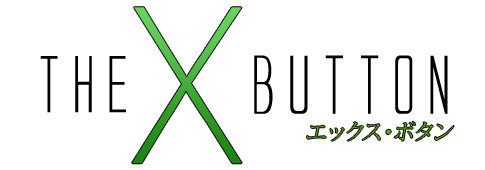
Considering that this column's going up just after election day, I'm not going to pretend that you're remotely as interested in video games as you are in who's going to lead the American people (besides the Illuminati, of course). That's why I'm going to be relevant and start off this column with America Daitoryo Senkyo, the only Japanese video game to tackle a U.S. presidential election in style. And by “in style” I mean “by constantly playing ‘My Old Kentucky Home’ and other public-domain music while showing 8-bit portraits of the 1988 candidates.”
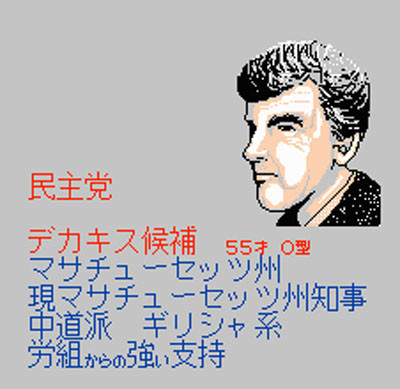
Ladies and gentlemen, I give you the new President of the United States of America: Michael Dukakis. No, really. Old Famicom games never lie.
NEWS
TATSUNOKO VS. CAPCOM GIVES ME NO PEACE
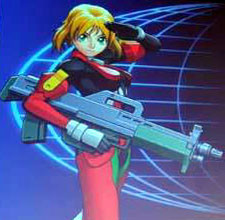 You know, the near-weekly announcements of new characters for Tatsunoko vs. Capcom would be more exciting if the game had a fair chance of seeing a North American release. Instead, we must summon our enthusiasm for importing the Japanese version and going through the bothersome and possibly expensive chore of running a Japanese Wii game. I imagine some will be swayed into that by the fact that Viewtiful Joe's star is now part of the cast.
You know, the near-weekly announcements of new characters for Tatsunoko vs. Capcom would be more exciting if the game had a fair chance of seeing a North American release. Instead, we must summon our enthusiasm for importing the Japanese version and going through the bothersome and possibly expensive chore of running a Japanese Wii game. I imagine some will be swayed into that by the fact that Viewtiful Joe's star is now part of the cast.
The other new Capcom addition is Saki Kanebo (right), an incredibly obscure choice (and I say this as someone who once knew all of Street Fighter Alpha 2's background cameos). Saki first appeared in Capcom's Quiz Nanairo Dreams, in which players answered questions put forth by a dating simulator's cast of girls. Saki was the sci-fi cosplayer of the bunch, and she later made cameos in Marvel vs. Capcom and those awesome SNK vs. Capcom: Cardfighter's Clash games. She's lugging around a real rifle in her Tatsunoko vs. Capcom incarnation, and the Capcom higher-up who likes her must be downright giddy over it.
Meanwhile, the Tatsunoko roster gets the lead from Gyakuten Ippatsu-man, a Tatsunoko superhero series from 1982. It's also an unfamiliar choice for the occidental viewer, though Ippatsu-man is technically a spin-off of Tatsunoko's incredibly popular Time Bokan TV series. He's another costumed champion of justice in a game that's already overflowing with them, but such was Tatsunoko's ethos in the 1980s.
BLEACH GOES BRAWLING
 You can already find a Bleach RPG, a Bleach strategy game, and a horde of Bleach fighters on modern systems, but I believe that Bleach: Soul Carnival is the first Bleach beat-'em-up in that old-fashioned Double Dragon vein. The PSP game drops huge-headed versions of Ichigo, Rukia, Renji, Kenpachi, and other prominent Bleach leads into side-scrolling levels full of hollows, rival reapers, and even Ganju's giant boars. The game thrives on a complex support system that links minor characters to a playable one, with the results varying depending on how much the supporters like their company (in other words, heroines get more results with Kon). It's a promising portable title from Racjin, a developer that's struggling to rebuild a reputation after its A.S.H. RPG flopped on the DS last year. A U.S. release might seem a good idea, but Bleach games haven't yet shown up here for any Sony systems. Curious, that.
You can already find a Bleach RPG, a Bleach strategy game, and a horde of Bleach fighters on modern systems, but I believe that Bleach: Soul Carnival is the first Bleach beat-'em-up in that old-fashioned Double Dragon vein. The PSP game drops huge-headed versions of Ichigo, Rukia, Renji, Kenpachi, and other prominent Bleach leads into side-scrolling levels full of hollows, rival reapers, and even Ganju's giant boars. The game thrives on a complex support system that links minor characters to a playable one, with the results varying depending on how much the supporters like their company (in other words, heroines get more results with Kon). It's a promising portable title from Racjin, a developer that's struggling to rebuild a reputation after its A.S.H. RPG flopped on the DS last year. A U.S. release might seem a good idea, but Bleach games haven't yet shown up here for any Sony systems. Curious, that.
EXAMU SEEKS NEW CROWD WITH DAEMON BRIDE
Capcom's Sengoku Basara X didn't set the world of fighting games aflame, but it proved that there's a market for pretty-boy fighters that cater to female fans. Examu, which already hit modern male moe-geeks on the nose with its Arcana Heart series, is now reaching out to another spectrum with Daemon Bride (romanized as Demon Blade elsewhere, but the official site makes it clear that there's marriage involved). Evidently aimed at the young women who can't stop squealing over Ky and Sol's relationship in Guilty Gear, Daemon Bride's two male leads are the priestly, feathered Kuon Summeragi and the chains-sporting, devil-winged Reizei Abane.
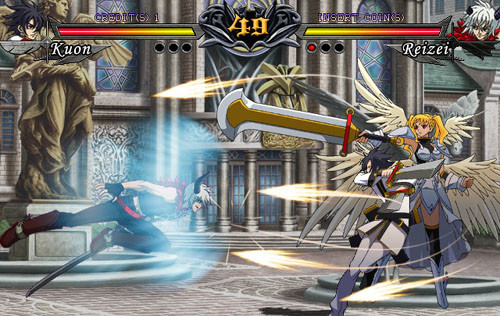
Not that it's all angsty men fighting at a futuristic netherworld academy. Daemon Blade also introduces three women: the blond, angelic Michael, the demonic Lucifer, and the scythe-wielding, slightly more ambiguous Kureha Yamisaki, all of whom should sate both Gothic Lolita fashion devotees and general goth-girl fans. And then there's Dawn, a bald, muscle-bound grappler whose right arm is a huge purple octopus. I really don't care to know what fetish he represents.
REVIEW: NEVERLAND CARD BATTLES
 Neverland Card Battles is part of an uncommon genre: the card-based strategy-RPG. Sure, we're drowning in anime-drenched strategy games and facing no shortage of RPGs that use cards in combat, but there's nothing here that mixes the two quite like Neverland. At the very least, sticking together two well-worn gameplay tropes makes it stand out in a world of pale Final Fantasy clones.
Neverland Card Battles is part of an uncommon genre: the card-based strategy-RPG. Sure, we're drowning in anime-drenched strategy games and facing no shortage of RPGs that use cards in combat, but there's nothing here that mixes the two quite like Neverland. At the very least, sticking together two well-worn gameplay tropes makes it stand out in a world of pale Final Fantasy clones.
The Neverland Card Battles we're getting here is a PSP port of an earlier PS2 title, which was another link in Idea Factory's loose chain of titles set in a world called Neverland. The series has inched over here with the marginalized Spectral Souls on the PSP and the lesser-liked Spectral Force 3 on the Xbox (and that god-awful Spectral Force anime), but I suspect there are few fans who will appreciate the characters and references in Neverland Card Battles.
Fortunately, players needn't bother keeping up on the backstory. It's a fairly routine yarn about Hellgaia, an ancient god of destruction who's sealed away in the form of cards. He awakens and possesses a despairing priestess, leaving Egma, the servant of the other gods, to recruit warriors (with cards) and send them to destroy Hellgaia (again, with cards) in the depths of an island labyrinth. Controlling the risk-hungry Galahad (who looks like he just stepped out of Saiyuki), players tread through battles with both servants of Hellgaia and the other chosen heroes.
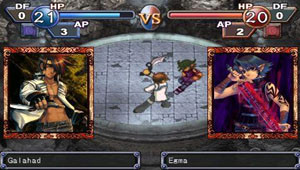 The localization sports some solid voice acting from the usual suspects, but they're stuck with all-too-familiar characters. There's a cocky gambler, a perky young lady who hates being called “little girl,” and other archetypes already seen in thousands of anime series and RPGs. Perhaps it would be easier to care if the conversations didn't have all the didactic card-game chatter of a Yu-Gi-Oh! episode. I know that when I encounter strangers in ancient catacombs, my first instinct is to duel them with cards while explaining the mechanics of summoning creatures on elemental tiles.
The localization sports some solid voice acting from the usual suspects, but they're stuck with all-too-familiar characters. There's a cocky gambler, a perky young lady who hates being called “little girl,” and other archetypes already seen in thousands of anime series and RPGs. Perhaps it would be easier to care if the conversations didn't have all the didactic card-game chatter of a Yu-Gi-Oh! episode. I know that when I encounter strangers in ancient catacombs, my first instinct is to duel them with cards while explaining the mechanics of summoning creatures on elemental tiles.
No one will remember Neverland Card Battles for its story or its rudimentary graphics (or its inoffensive soundtrack), but the combat finds unique space. Battles play out in grids with sprite-based characters treading around a few squares at a time, but everything's governed by decks of cards. The playing field is initially bare but for two dominators, who use what they're dealt to summon allies or unleash nasty effects on enemies. The key to victory lies in wearing down the other dominator's hit points, but that's always complicated when the enemy builds an army of bug-fish, armored knights, and ghosts to stand in your way. Every direct confrontation has two characters smacking each other around on a separate screen, a sight that's not as exciting as it wants to be, due to the average graphics and frequent loading.
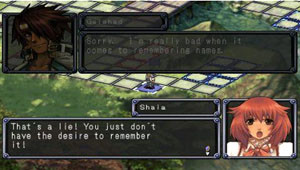 Yet it's the overriding flow of a confrontation that keeps Neverland Card Battles above water. When you're not conjuring up soldiers and raining firestorms down on your foes, you're trying to stake out as much territory as possible. Squares of the battlefield change color when you and your allies walk across them, and the more space you claim, the more powerful forces you'll have. Of course, your opponent's trying the same strategy, and the resulting contest adds to a potentially staid array of card-dealing and attacking.
Yet it's the overriding flow of a confrontation that keeps Neverland Card Battles above water. When you're not conjuring up soldiers and raining firestorms down on your foes, you're trying to stake out as much territory as possible. Squares of the battlefield change color when you and your allies walk across them, and the more space you claim, the more powerful forces you'll have. Of course, your opponent's trying the same strategy, and the resulting contest adds to a potentially staid array of card-dealing and attacking.
Neverland Card Battles doesn't have the length or the narrative pull to scrape the likes of Final Fantasy Tactics or Disgaea, but there's a halfway compelling challenge within the card decks and land-grabbing battles. I can only hope Yuke's release does well enough to create a robust online community, since the game's at its most appealing with a human opponent and an unpredictable assortment of cards to face. And that's enough to put Neverland Card Battles at the forefront of card-based strategy-RPGs, however bare than field may be.
RELEASES FOR THE WEEK OF 11-9
ETERNAL POISON |
|
MIRROR'S EDGE (EA., Xbox 360/PS3/PC, $59.99)  Mirror's Edge is yet another fourth-quarter release that's too big for even the insular anime-and-RPG fan to ignore. It's also a clever use of urban parkour, albeit one romanticized so the runners are dashing, flipping, and bouncing off walls to carry out covert missions and stymie a joyless future city's totally un-cool police force. It looks like a stylish Nike commercial, but Mirror's Edge makes full use of its concept and 3-D environments, and screwing around with the forgiving physics of parkour is half the fun. Perhaps it would be easier if you could actually see your character, Faith, as she bounds across rooftops and swings from helicopter undercarriages, but the first-person perspective gives Mirror's Edge an authentic touch of vertigo. The combat also relies heavily on hand-to-hand moves with occasional firearm use, similar to Namco's Breakdown, a largely forgotten first-person action game for the Xbox. Something tells me that Mirror's Edge won't be ignored so easily. Mirror's Edge is yet another fourth-quarter release that's too big for even the insular anime-and-RPG fan to ignore. It's also a clever use of urban parkour, albeit one romanticized so the runners are dashing, flipping, and bouncing off walls to carry out covert missions and stymie a joyless future city's totally un-cool police force. It looks like a stylish Nike commercial, but Mirror's Edge makes full use of its concept and 3-D environments, and screwing around with the forgiving physics of parkour is half the fun. Perhaps it would be easier if you could actually see your character, Faith, as she bounds across rooftops and swings from helicopter undercarriages, but the first-person perspective gives Mirror's Edge an authentic touch of vertigo. The combat also relies heavily on hand-to-hand moves with occasional firearm use, similar to Namco's Breakdown, a largely forgotten first-person action game for the Xbox. Something tells me that Mirror's Edge won't be ignored so easily. Get Excited If: You've ever popped in Casino Royale just to watch the parkour chase. |
|
POKEMON RANGER: SHADOWS OF ALMIA (Nintendo, DS, $34.99)  Before I discuss Pokemon Ranger and the apparently dimly lit Almia, I'd like to point out something about the kids who first latched on to Pokemon when the games first hit the U.S. in 1998. Assuming they were eight years old then, those kids are now voting, driving, and going to college. But are they still playing Pokemon games? I doubt that, but Pokemon has proven quite efficient at finding new meat for the monster-catching grinder. The latest campaign is Pokemon Ranger: Shadows of Almia, a sequel to 2006's un-subtitled Pokemon Ranger. It's still a stylus-based RPG, but Almia offers a new country to explore, new Pokemon to catch, and a system where players can pick their own Pokemon sidekick, who apparently works much like Pikachu did in the cartoons ten years ago. Before I discuss Pokemon Ranger and the apparently dimly lit Almia, I'd like to point out something about the kids who first latched on to Pokemon when the games first hit the U.S. in 1998. Assuming they were eight years old then, those kids are now voting, driving, and going to college. But are they still playing Pokemon games? I doubt that, but Pokemon has proven quite efficient at finding new meat for the monster-catching grinder. The latest campaign is Pokemon Ranger: Shadows of Almia, a sequel to 2006's un-subtitled Pokemon Ranger. It's still a stylus-based RPG, but Almia offers a new country to explore, new Pokemon to catch, and a system where players can pick their own Pokemon sidekick, who apparently works much like Pikachu did in the cartoons ten years ago. Get Excited If: You actually know the names of some of the new Pokemon from Ranger. |
|
TALES OF SYMPHONIA: DAWN OF A NEW WORLD (Namco Bandai, Wii, $39.99)  Namco makes a new Tales RPG every Wednesday, but rarely is it a direct sequel. Tales of Destiny got a follow-up and a remake, but the Gamecube-based Tales of Symphonia shows every sign of being the second most popular Tales title. It gets a sequel in Dawn of a New World, in which the events of the first game have paved the way for another round of church-and-state warfare. The new lead is Emil, a young man who lost a family when said warfare wiped out his home city, and he'll run into Lloyd, Sheena, and other familiar Symphonia characters. The battle system reflects the action-game focus of other Tales titles, though Dawn of a New World pays more attention to elemental attributes and their effects on battle. It's called the Flex Ranged Element Enhanced Linear Motion Battle System, and I swear that's the official, Namco-endorsed name for it. I just hope the dialogue isn't an indecipherable mess of words like “exsphere” and “key crest.” Namco makes a new Tales RPG every Wednesday, but rarely is it a direct sequel. Tales of Destiny got a follow-up and a remake, but the Gamecube-based Tales of Symphonia shows every sign of being the second most popular Tales title. It gets a sequel in Dawn of a New World, in which the events of the first game have paved the way for another round of church-and-state warfare. The new lead is Emil, a young man who lost a family when said warfare wiped out his home city, and he'll run into Lloyd, Sheena, and other familiar Symphonia characters. The battle system reflects the action-game focus of other Tales titles, though Dawn of a New World pays more attention to elemental attributes and their effects on battle. It's called the Flex Ranged Element Enhanced Linear Motion Battle System, and I swear that's the official, Namco-endorsed name for it. I just hope the dialogue isn't an indecipherable mess of words like “exsphere” and “key crest.” Get Excited If: You know why Kratos won't be playable in the Symphonia sequel. |
EXTRA LIVES: ZILLION
 Seldom does an anime series influence a game console like Zillion did the Sega Master System. Sega was a major sponsor of the Zillion TV series, and the light gun that came with the Master System is a perfect copy of the pistol (and plot device) from the Zillion anime and the Lazer Tag-style toy it inspired. It's not even a stretch to see Zillion's future-1980s design in the trapezoidal, faux-futuristic look of the Master System itself. It was inevitable that Sega would give that system a Zillion game of its own, and the result was one of its defining titles, a gauntlet that young Master System owners could throw down when their NES-owning friends started talking about Metroid and The Legend of Zelda and Mega Man 2 and Contra and The Guardian Legend and Ninja Gaiden and Super Mario Bros. 3 and…well, a lot of excellent games that the Master System would never have. But those NES kids didn't get Zillion.
Seldom does an anime series influence a game console like Zillion did the Sega Master System. Sega was a major sponsor of the Zillion TV series, and the light gun that came with the Master System is a perfect copy of the pistol (and plot device) from the Zillion anime and the Lazer Tag-style toy it inspired. It's not even a stretch to see Zillion's future-1980s design in the trapezoidal, faux-futuristic look of the Master System itself. It was inevitable that Sega would give that system a Zillion game of its own, and the result was one of its defining titles, a gauntlet that young Master System owners could throw down when their NES-owning friends started talking about Metroid and The Legend of Zelda and Mega Man 2 and Contra and The Guardian Legend and Ninja Gaiden and Super Mario Bros. 3 and…well, a lot of excellent games that the Master System would never have. But those NES kids didn't get Zillion. And Zillion certainly made an impression. Before the game can even pull up a Sega logo, a huge image of alpha-hero J.J. appears onscreen and fires his Sega-brand Zillion pistol right in your face. Nor does Zillion fuss about with long introductions: as J.J., you're quickly shoved out of a spaceship and told to blow up the Noza (or “Norsa,” as the game spells it) base you're standing on, but not before you've rescued your captured comrades, the cocky Champ and the efficient Apple, the latter of whom is misidentified as a man in the game's instructions.
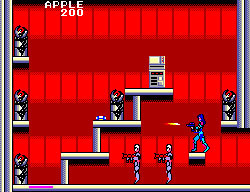 All of this arrived less than a year after Nintendo's Metroid, and Zillion indeed mimics Metroid's mazelike approach. They're vastly different in tone, however; Metroid is bleak and claustrophobic, while Zillion is a glowing, antiseptic maze that lands closer to Epyx's old computer game Impossible Mission. Zillion's enemy base is a web of sharp-colored steel tunnels, elevators, and rooms locked off by keycards and passwords. There's a lot of backtracking and experimenting involved, as J.J. must retrieve and memorize a four-part password for each room by destroying canisters and picking up an ID card for every computer terminal.
All of this arrived less than a year after Nintendo's Metroid, and Zillion indeed mimics Metroid's mazelike approach. They're vastly different in tone, however; Metroid is bleak and claustrophobic, while Zillion is a glowing, antiseptic maze that lands closer to Epyx's old computer game Impossible Mission. Zillion's enemy base is a web of sharp-colored steel tunnels, elevators, and rooms locked off by keycards and passwords. There's a lot of backtracking and experimenting involved, as J.J. must retrieve and memorize a four-part password for each room by destroying canisters and picking up an ID card for every computer terminal.
All the while, J.J. is evading energy fields, laser turrets, and roving Noza android-creatures that get progressively nastier as the game continues. His moves are the usual fire-and-jump repertoire, with one uncommon addition: he can crawl on his stomach to duck enemy fire, snipe at foes, and sneak through passages. Apple and Champ can do the same once they're rescued, giving players three different characters that balance speed and endurance to varying degrees.
Like most of the better Master System games, Zillion looks impressive for its day, with vibrant colors and animation just slightly beyond any NES games of the same period. Still, the anime atmosphere is confined mostly to short conversations and a perky soundtrack. Zillion doesn't go for elaborate cutscenes, though mothership operator Amy and the show's major villain show up in one of the most hilariously overdramatic “Game Over” screens ever.
 Zillion isn't quite as amazing as it was back in 1987. For one thing, having to ferret out a passcode in nearly every room gets a bit dull. Also repetitive is the game's overuse of basic Noza mecha-things as enemies; for the first twenty minutes or so, they're the only opposition you'll really encounter. There's also no password system, forcing you to play through the whole thing in one go (and, presumably, write down every passcode), and the game's three continues are easily used up in the early stages of JJ going it alone.
Zillion isn't quite as amazing as it was back in 1987. For one thing, having to ferret out a passcode in nearly every room gets a bit dull. Also repetitive is the game's overuse of basic Noza mecha-things as enemies; for the first twenty minutes or so, they're the only opposition you'll really encounter. There's also no password system, forcing you to play through the whole thing in one go (and, presumably, write down every passcode), and the game's three continues are easily used up in the early stages of JJ going it alone.
Sega returned to Zillion for a Master System sequel, subtitled “The Tri-Formation,” but it's a bland combination of bike-racing and shooting stages, and only J.J. is playable. There would be no Zillion games on later Sega systems, either, as the company and the anime parted ways, even though Opa-Opa, the mascot of Sega's Fantasy Zone games, was Zillion's resident Haro-like sidekick.
The Zillion anime never caught on in the U.S., where only a few episodes of the TV series (and the hysterical OVA) were dubbed and released by Streamline. Still, the first game was there when it counted for Sega Master System owners who wanted something a little deeper than the usual arcade-game ports. Zillion doesn't beat Metroid at its own game, but it's still capable of pulling in anime fans and anyone seeking a captivating, old-fashioned challenge.
A copy of Zillion, complete with its terribly nondescript box art, should run no more than ten bucks online. I'm surprised that it's not on the Wii's Virtual Console. Perhaps some legal fallout remains from Sega and Zillion's breakup.
discuss this in the forum (16 posts) |
this article has been modified since it was originally posted; see change history
 Here we find further proof that Atlus has subsumed the role of Working Designs, the late publisher of such cult classics as Lunar and Popful Mail. In the 1990s, Working Designs was in the habit of supporting doomed systems like the Sega CD and Sega Saturn to their dying days. Today, it's Atlus that supplies RPGs for the PlayStation 2 long after other high-profile companies have moved on. Then again, Eternal Poison would merit notice even in a more crowded playing field; its setting and art resemble some blend of Crusades-era Arabian architecture and gothic-lolita anime trends, and it features a huge cast of mercenaries, knights, royalty, and other scheming factions. Beneath all the subplots and holy wars, there's a strategy-RPG that heavily emphasizes defeating demons called Majin and customizing these captured foes to your liking. The developer, Flight-Plan, has a history ranging from the well-liked Summon Night series to a cleaned-up PS2 port of the Utawarerumono game, but Eternal Poison seems ambitious beyond the usual strategic fare.
Here we find further proof that Atlus has subsumed the role of Working Designs, the late publisher of such cult classics as Lunar and Popful Mail. In the 1990s, Working Designs was in the habit of supporting doomed systems like the Sega CD and Sega Saturn to their dying days. Today, it's Atlus that supplies RPGs for the PlayStation 2 long after other high-profile companies have moved on. Then again, Eternal Poison would merit notice even in a more crowded playing field; its setting and art resemble some blend of Crusades-era Arabian architecture and gothic-lolita anime trends, and it features a huge cast of mercenaries, knights, royalty, and other scheming factions. Beneath all the subplots and holy wars, there's a strategy-RPG that heavily emphasizes defeating demons called Majin and customizing these captured foes to your liking. The developer, Flight-Plan, has a history ranging from the well-liked Summon Night series to a cleaned-up PS2 port of the Utawarerumono game, but Eternal Poison seems ambitious beyond the usual strategic fare.